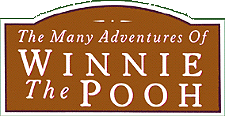

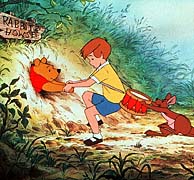 Directed
by: Wolfgang Reitherman & John Lounsbery
Directed
by: Wolfgang Reitherman & John Lounsbery
Written by: Ken Anderson
Music by: Richard M.
& Robert B. Sherman
Released on: March 11, 1977
Running Time: 74 minutes
Budget: $
Box-Office: $

Narrator... Sebastian Cabot
 Winnie
the Pooh... Sterling Holloway
Winnie
the Pooh... Sterling Holloway
Eeyore... Ralph Wright
Piglet... John Fiedler
Rabbit... Junius Matthews
Tigger... Paul Winchell
Christopher Robin... Jon Walmsley, Bruce
Reitherman, Timothy Turner
Roo... Client Howard, Dori Whitaker
Kanga... Barbara Luddy
Owl... Hal Smith
Gopher... Howard Morris

![]() This is a compilation
of the following short movies:
This is a compilation
of the following short movies:
![]() Walt Disney's first
choice to play the voice of Winnie the Pooh was 1960s TV comic George Gobel.
But the comedian turned down the offer after readin the A.A. Milne books,
as found the bear an awful bore.
Walt Disney's first
choice to play the voice of Winnie the Pooh was 1960s TV comic George Gobel.
But the comedian turned down the offer after readin the A.A. Milne books,
as found the bear an awful bore.
![]() According to Jim
Hill, Walt Disney had hoped that if he had a big-time TV talent like
George Gobel on board, he could justify to Roy his idea of turning the
Winnie the Pooh books into a full length animated feature for the studio.
But with no celebrity on board the Pooh project became a lower priority
at Disney studios. Walt didn't think that the Milne stories were strong
enough to support a feature all on their own (Disney was still smarting
from the less-than-enthusiastic reception for the company's last animated
feature, The Sword in the Stone.
Walt blamed most of the film's failure on its source material--T.H. White's
fanciful novel about the origin of King Arthur. "This whimsical English
stuff just doesn't appeal to American audiences," Disney was supposed to
have grumbled at the time). But rather than walk away from two years of
development on the project, Disney opted to do a single short based on
Milne's books: Winnie the Pooh and the Honey Tree, with Walt's second choice,
Sterling Holloway voicing Edward Bear, hit theaters in February 1966.
According to Jim
Hill, Walt Disney had hoped that if he had a big-time TV talent like
George Gobel on board, he could justify to Roy his idea of turning the
Winnie the Pooh books into a full length animated feature for the studio.
But with no celebrity on board the Pooh project became a lower priority
at Disney studios. Walt didn't think that the Milne stories were strong
enough to support a feature all on their own (Disney was still smarting
from the less-than-enthusiastic reception for the company's last animated
feature, The Sword in the Stone.
Walt blamed most of the film's failure on its source material--T.H. White's
fanciful novel about the origin of King Arthur. "This whimsical English
stuff just doesn't appeal to American audiences," Disney was supposed to
have grumbled at the time). But rather than walk away from two years of
development on the project, Disney opted to do a single short based on
Milne's books: Winnie the Pooh and the Honey Tree, with Walt's second choice,
Sterling Holloway voicing Edward Bear, hit theaters in February 1966.
![]() Walt Disney wanted Wally
Boag, his favorite performer, to do the voice of Tigger. But the vaudevillian's
take on the character was just too zany for a children's film. Disney opted
instead to get ventriloquist Paul Winchell to do Tigger's voice.
Walt Disney wanted Wally
Boag, his favorite performer, to do the voice of Tigger. But the vaudevillian's
take on the character was just too zany for a children's film. Disney opted
instead to get ventriloquist Paul Winchell to do Tigger's voice.
![]() John Lounsbery directed
Winnie
the Pooh and Tigger Too. Don Bluth was
an animator on the short along with Gary Goldman and John Pomeroy. T
John Lounsbery directed
Winnie
the Pooh and Tigger Too. Don Bluth was
an animator on the short along with Gary Goldman and John Pomeroy. T
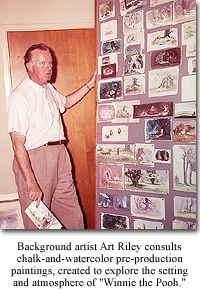
![]() Just as with the Mary Poppins books,
Walt Disney was introduced to the "Winnie the Pooh" books through his daughter,
Diane Disney Miller. "Dad would hear me laughing alone in my room and come
in to see what I was laughing at," recalls Diane. "It was usually the gentle,
whimsical humor of A.A. Milne's Pooh stories. I read them over and over,
and then many years later to my children, and now to my grandchildren.
The heffalump hunt is still my favorite."
Just as with the Mary Poppins books,
Walt Disney was introduced to the "Winnie the Pooh" books through his daughter,
Diane Disney Miller. "Dad would hear me laughing alone in my room and come
in to see what I was laughing at," recalls Diane. "It was usually the gentle,
whimsical humor of A.A. Milne's Pooh stories. I read them over and over,
and then many years later to my children, and now to my grandchildren.
The heffalump hunt is still my favorite."
![]() Walt Disney's goal was
to preserve the delicate charm and whimsical wit of the original "Pooh"
books, written by A.A. Milne and illustrated by E. H. Shepard. "Walt told
us to stick to what Milne had written," recalls veteran Disney artist Bill
Justice. "He said there's a certain charm in the writing and we shouldn't
change too much." "Walt said we should keep the whimsy," says story artist
Vance Gerry. "Then we had a meeting to decide what 'whimsy' was."
Walt Disney's goal was
to preserve the delicate charm and whimsical wit of the original "Pooh"
books, written by A.A. Milne and illustrated by E. H. Shepard. "Walt told
us to stick to what Milne had written," recalls veteran Disney artist Bill
Justice. "He said there's a certain charm in the writing and we shouldn't
change too much." "Walt said we should keep the whimsy," says story artist
Vance Gerry. "Then we had a meeting to decide what 'whimsy' was."
![]() The original Pooh books
feature "hums," poems made up by Pooh. Though the Disney Pooh films do
not include direct adaptations of the hums penned by A. A. Milne, Richard
and Robert Sherman, the virtuoso team of songwriting brothers, set out
to capture their fanciful flavor. "The books are so charming and so filled
with whimsy," notes Richard Sherman, adding that the Sherman songs were
"a deliberate effort on our part to sound like Milne. He had written little
'hums' in the books. They weren't really songs. They were like little feathers
in the breeze, so we wanted to get that feel in our songs -- that if Milne
had written a song, he most likely would have written it that way." The
brothers refer to "Rumbly in My Tumbly" as a Pooh song with a "Milnesque"
sound. "It feels like Milne, although it isn't Milne," states Robert Sherman.
"It's Sherman." "We wanted to be Milnesque," adds Richard Sherman, "but
it had to be Disney too."
The original Pooh books
feature "hums," poems made up by Pooh. Though the Disney Pooh films do
not include direct adaptations of the hums penned by A. A. Milne, Richard
and Robert Sherman, the virtuoso team of songwriting brothers, set out
to capture their fanciful flavor. "The books are so charming and so filled
with whimsy," notes Richard Sherman, adding that the Sherman songs were
"a deliberate effort on our part to sound like Milne. He had written little
'hums' in the books. They weren't really songs. They were like little feathers
in the breeze, so we wanted to get that feel in our songs -- that if Milne
had written a song, he most likely would have written it that way." The
brothers refer to "Rumbly in My Tumbly" as a Pooh song with a "Milnesque"
sound. "It feels like Milne, although it isn't Milne," states Robert Sherman.
"It's Sherman." "We wanted to be Milnesque," adds Richard Sherman, "but
it had to be Disney too."
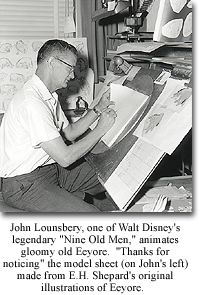
![]() Written by the Shermans in 1964, "The Wonderful Thing About Tigger" was
not sung on-screen until the rambunctious Tigger made his film debut in
the second "Pooh" featurette, "Winnie the Pooh and the Blustery Day" (1968).
Tigger's bouncy theme had a second verse that was not heard in "Blustery
Day." Though included on Disney record album retellings of the "Pooh" stories,
"The Wonderful Thing About Tigger" was not heard onscreen in its entirety
until "The Tigger Movie" (2000).
Written by the Shermans in 1964, "The Wonderful Thing About Tigger" was
not sung on-screen until the rambunctious Tigger made his film debut in
the second "Pooh" featurette, "Winnie the Pooh and the Blustery Day" (1968).
Tigger's bouncy theme had a second verse that was not heard in "Blustery
Day." Though included on Disney record album retellings of the "Pooh" stories,
"The Wonderful Thing About Tigger" was not heard onscreen in its entirety
until "The Tigger Movie" (2000).
![]() In creating the musical
score for the "Winnie the Pooh" featurettes, musical arranger Buddy Baker
used musical instruments to help define the delightful personalities of
the Hundred Acre Wood denizens. Pooh was represented by a baritone horn,
Rabbit by a clarinet, Owl by the ocarina and French horn, Kanga by a flute
and Roo by a piccolo, Piglet by the oboe, and Eeyore by a bass clarinet.
In creating the musical
score for the "Winnie the Pooh" featurettes, musical arranger Buddy Baker
used musical instruments to help define the delightful personalities of
the Hundred Acre Wood denizens. Pooh was represented by a baritone horn,
Rabbit by a clarinet, Owl by the ocarina and French horn, Kanga by a flute
and Roo by a piccolo, Piglet by the oboe, and Eeyore by a bass clarinet.
![]() Tigger was not in the
first "Pooh" featurette. The rambunctious tiger did not bounce along until
"Winnie the Pooh and the Blustery Day" (1968). Although a primitive version
of Piglet appeared on the Hundred Acre Wood map at the start of "Winnie
the Pooh and the Honey Tree," Piglet also made his first storyline appearance
in "Blustery Day."
Tigger was not in the
first "Pooh" featurette. The rambunctious tiger did not bounce along until
"Winnie the Pooh and the Blustery Day" (1968). Although a primitive version
of Piglet appeared on the Hundred Acre Wood map at the start of "Winnie
the Pooh and the Honey Tree," Piglet also made his first storyline appearance
in "Blustery Day."
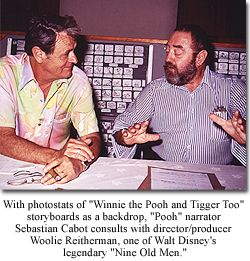
![]() Christopher
Robin was named after author A.A. Milne's son, Christopher.
Christopher
Robin was named after author A.A. Milne's son, Christopher.
![]() In the 1997 Disney Channel
print of this movie, a large portion of this movie is replaced. Everything
past the song, "Hip hip hooray" is replaced by the short, "Winnie the Pooh
and a Day for Eeyore". This means that instead of the "Winnie the Pooh
and Tigger Too" and "We Say Goodbye" sequences, is "Winnie the Pooh and
a Day for Eeyore".
In the 1997 Disney Channel
print of this movie, a large portion of this movie is replaced. Everything
past the song, "Hip hip hooray" is replaced by the short, "Winnie the Pooh
and a Day for Eeyore". This means that instead of the "Winnie the Pooh
and Tigger Too" and "We Say Goodbye" sequences, is "Winnie the Pooh and
a Day for Eeyore".
![]() The Many Adventures
of Winnie the Pooh, opened in Fantasyland on 5th June 1999, replacing the
earlier and much loved Mr Toad's Wild Ride, which had been in the Magic
Kingdom ever since the park first opened in 1971. The ride focuses
on a voyage through the Hundred Acre Wood in Honey-Pot shaped vehicles
during which many of the events in the books are retold in classic Disney
style. Along the way guests encounter a Blustery Day: Owl's toppling
house, bounce along with Tigger, appear in Pooh's dream of Heffalumps and
Woozles, save Piglet from the rising water in a Floody Place and, finally,
arrive at one honey of a party with the whole gang.
The Many Adventures
of Winnie the Pooh, opened in Fantasyland on 5th June 1999, replacing the
earlier and much loved Mr Toad's Wild Ride, which had been in the Magic
Kingdom ever since the park first opened in 1971. The ride focuses
on a voyage through the Hundred Acre Wood in Honey-Pot shaped vehicles
during which many of the events in the books are retold in classic Disney
style. Along the way guests encounter a Blustery Day: Owl's toppling
house, bounce along with Tigger, appear in Pooh's dream of Heffalumps and
Woozles, save Piglet from the rising water in a Floody Place and, finally,
arrive at one honey of a party with the whole gang.
![]() In what has been described
as the biggest rights deal in British literary history, the Walt Disney
Co. paid $350 million in March 2001 for use of the characters in the Winnie-the-Pooh
books in merchandising, film, television and the theater over the next
25 years. The principal beneficiaries will be the Royal Literary Fund,
the Garrick Club and Westminster school. The widow of Christopher Robin
Milne, son of A.A. Milne, author of the Pooh books, will receive nothing,
having sold his quarter-share in royalties to the Literary fund for $225,000
before his death. "Christopher was very anti-Disney," Lesley Milne, the
widow, told the London Sunday Times. He hated what they had done with the
books and the characters. Christopher just wasn't interested in money,
either."
In what has been described
as the biggest rights deal in British literary history, the Walt Disney
Co. paid $350 million in March 2001 for use of the characters in the Winnie-the-Pooh
books in merchandising, film, television and the theater over the next
25 years. The principal beneficiaries will be the Royal Literary Fund,
the Garrick Club and Westminster school. The widow of Christopher Robin
Milne, son of A.A. Milne, author of the Pooh books, will receive nothing,
having sold his quarter-share in royalties to the Literary fund for $225,000
before his death. "Christopher was very anti-Disney," Lesley Milne, the
widow, told the London Sunday Times. He hated what they had done with the
books and the characters. Christopher just wasn't interested in money,
either."
![]() Art Stevens was given
the assignment of hooking the three Poohs together with additional animation.
He directed the hook-ups. Don Bluth and Gary Goldman were not involved
in any of it, although they did animate on Winnie the Pooh and Tigger
Too (the third half-hour theatrical), back in 1974. Don animated the
sequence where the characters were "lost in the mist". He also animated
one scene of Christopher Robin coming up to the group as they held the
blanket to catch Roo and Tigger. John Pomeroy worked on part of the end
of the 3rd Pooh. He did some of the Christopher Robins plus Tigger's long
sad walk away from camera. Gary worked on the ice skating sequence; Roo
up in the tree with Tigger; and Pooh and Piglet finding Roo in the tree.
Art Stevens was given
the assignment of hooking the three Poohs together with additional animation.
He directed the hook-ups. Don Bluth and Gary Goldman were not involved
in any of it, although they did animate on Winnie the Pooh and Tigger
Too (the third half-hour theatrical), back in 1974. Don animated the
sequence where the characters were "lost in the mist". He also animated
one scene of Christopher Robin coming up to the group as they held the
blanket to catch Roo and Tigger. John Pomeroy worked on part of the end
of the 3rd Pooh. He did some of the Christopher Robins plus Tigger's long
sad walk away from camera. Gary worked on the ice skating sequence; Roo
up in the tree with Tigger; and Pooh and Piglet finding Roo in the tree.
![]() In 1993, the Walt Disney
Company acknowledged that Pooh Bear was second only to Mickey Mouse as
Disney's most-loved and trusted character. In 1996, after the second release
of The Many Adventures Of Winnie The Pooh, Pooh pulled into first place.
In 1993, the Walt Disney
Company acknowledged that Pooh Bear was second only to Mickey Mouse as
Disney's most-loved and trusted character. In 1996, after the second release
of The Many Adventures Of Winnie The Pooh, Pooh pulled into first place.
 During
the first World War, troops from Winnipeg (Manitoba, Canada) were being
transported to eastern Canada, on their way to Europe, where they were
to join the 2nd Canadian Infantry Brigade. When the train stopped at White
River, Ontario, a lieutenant called Harry Colebourn bought a small female
black bear cub for $20 from a hunter who had killed its mother. He named
her 'Winnipeg', after his hometown of Winnipeg, or 'Winnie' for short.
During
the first World War, troops from Winnipeg (Manitoba, Canada) were being
transported to eastern Canada, on their way to Europe, where they were
to join the 2nd Canadian Infantry Brigade. When the train stopped at White
River, Ontario, a lieutenant called Harry Colebourn bought a small female
black bear cub for $20 from a hunter who had killed its mother. He named
her 'Winnipeg', after his hometown of Winnipeg, or 'Winnie' for short.
Winnie became the mascot of the Brigade and went to Britain with the unit. When the Brigade was posted to the battlefields of France, Colebourn, now a Captain, took Winnie to the London Zoo for a long loan. He formally presented the London Zoo with Winnie in December 1919 where he became a popular attraction and lived until 1934.
The bear was also very popular with Christopher Robin, son of author A.A. Milne. It was his favourite animal at the Zoo, and he often spent time inside the cage with it. The bear was Christopher Robin's inspiration for calling his own teddy bear Winnie.....Winnie the Pooh (this teddy bear started out with the name of Edward Bear). The name Pooh originally belonged to a swan, as can be seen in the introduction of Milne's 'When We Were Very Young'.
A.A. Milne started to write a series of books about Winnie the Pooh, his son Christopher Robin, and their friends in the "100 Aker Wood." These other characters, such as Eeyore, Piglet, Tigger, Kanga and Roo were also based on stuffed animals belonging to Christopher Robin. The characters, Rabbit and Owl, were based on animals that lived, like the swan Pooh, in the surrounding area of Milne's country home, Cotchford Farm in Ashdown Forest in Sussex, Southern England. It is this area on which the 100-Acre-Wood was based.
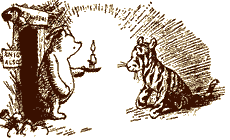 The
first Pooh story, "The Wrong Sort of Bees," was published in the London
Evening News in 1925. It was so popular Milne wrote a host of Pooh books
and poetry volumes over the next three years: "Winnie-the-Pooh" was published
by Methuen on October 14th, 1926, the verses 'Now We are Six' in 1927,
and 'The House at Pooh Corner' in1928. All these books were illustrated
in a beautiful way by E.H. Shepard, which made the books even more magical.
The Pooh-books became firm favorites with old and young alike and have
been translated into more than 40 languages, including Thai, Hebrew and
Braille; Germans know the bear as Winnie der Pu, while Russians call him
Vinnie Pookh and Norwegians know him as Ole Brumm. . A conservative figure
for the total sales of the four Methuen editions (including When We Were
Very Young) up to the end of 1996 would be over 20 million copies. These
figures do not include sales of the four books published by Dutton in Canada
and the States, nor the foreign-language editions printed in more than
25 languages the world over!
The
first Pooh story, "The Wrong Sort of Bees," was published in the London
Evening News in 1925. It was so popular Milne wrote a host of Pooh books
and poetry volumes over the next three years: "Winnie-the-Pooh" was published
by Methuen on October 14th, 1926, the verses 'Now We are Six' in 1927,
and 'The House at Pooh Corner' in1928. All these books were illustrated
in a beautiful way by E.H. Shepard, which made the books even more magical.
The Pooh-books became firm favorites with old and young alike and have
been translated into more than 40 languages, including Thai, Hebrew and
Braille; Germans know the bear as Winnie der Pu, while Russians call him
Vinnie Pookh and Norwegians know him as Ole Brumm. . A conservative figure
for the total sales of the four Methuen editions (including When We Were
Very Young) up to the end of 1996 would be over 20 million copies. These
figures do not include sales of the four books published by Dutton in Canada
and the States, nor the foreign-language editions printed in more than
25 languages the world over!
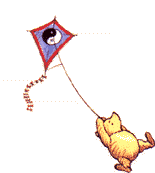 The
Pooh-books had also been favourites of Walt Disney's daughters and it inspired
Disney to bring Pooh to film in 1966. In 1977 'the Many Adventures of Winnie
the Pooh', the first feature-length animated film of Pooh was released.
In 1993, the Walt Disney Company acknowledged that Pooh Bear is second
only to Mickey Mouse in their portfolio of the most-loved and trusted characters
known to millions of people all over the world. By 1996, after the second
release of The Many Adventures of Winnie the Pooh, the Bear of Very
Little Brain had proven to be more popular than any other Disney character.
In 1997, twenty years after the release of the first feature-length animated
film, Disney released Pooh's Grand Adventure, picking up where Disney's
22nd Masterpiece left off. In February 2000 Disney released the third Winnie
the Pooh movie called The Tigger Movie,
this time with the leading part for Tigger. A fourth project, tentatively
called Piglet's Big Movie and centered around, you guessed it, Piglet's
character, is rumoured to be currently in the works.
The
Pooh-books had also been favourites of Walt Disney's daughters and it inspired
Disney to bring Pooh to film in 1966. In 1977 'the Many Adventures of Winnie
the Pooh', the first feature-length animated film of Pooh was released.
In 1993, the Walt Disney Company acknowledged that Pooh Bear is second
only to Mickey Mouse in their portfolio of the most-loved and trusted characters
known to millions of people all over the world. By 1996, after the second
release of The Many Adventures of Winnie the Pooh, the Bear of Very
Little Brain had proven to be more popular than any other Disney character.
In 1997, twenty years after the release of the first feature-length animated
film, Disney released Pooh's Grand Adventure, picking up where Disney's
22nd Masterpiece left off. In February 2000 Disney released the third Winnie
the Pooh movie called The Tigger Movie,
this time with the leading part for Tigger. A fourth project, tentatively
called Piglet's Big Movie and centered around, you guessed it, Piglet's
character, is rumoured to be currently in the works.
Christopher Milne, a writer and bookseller who died in 1996, was uncomfortable with celebrity and once wrote that his father had "filched from me my good name and had left me with nothing but the empty fame of being his son." But in a later book, he made it clear he had come to cherish his history. Alan Alexander Milne rarely read his works to his son: "My father did not write the books for children. He didn't write for any specific market; he knew nothing about marketing. He knew about me, he knew about himself, he knew about the Garrick Club (in London) -- he was ignorant about anything else. Except, perhaps, about life."
The Pooh Sticks Bridge in Ashdown Forest, where the Milne family had
a cottage, was renovated and reopened in 1979 by Christopher Robin.
67,000 visitors toss twigs into the stream below every year and watch them
race into the distance in imitation of Pooh and the fictitious Christopher
Robin, his human pal. And if you ever visit the London zoo, you will see
real-life pictures of a young Christopher feeding the bear condensed milk!
|
||||||||||||